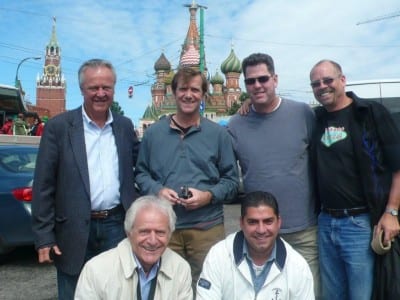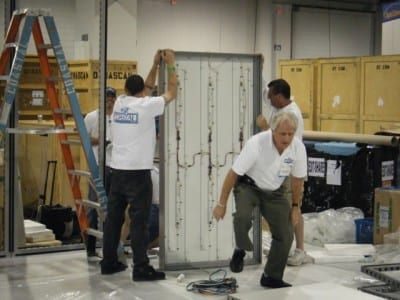Worldwide tradeshow marketing has been rapidly growing for the past 20 years. Exhibit suppliers here in the U.S. have acted slower than any other region in the rest of the world when it came to getting aggressive to work beyond their North American borders. It is only in recent years that exhibit design and production companies here in the U.S. are beginning to catch up, serving their customers aggressively abroad. There are several reasons for this trend reversal. (See my article Trendspotters Survey – January 13, 2013 in ECN for further info)
 Although the trend to serve tradeshow customers worldwide is picking up a head of steam, quite a few U.S. tradeshow supplier companies and individuals saw this trend coming long before it gained its popularity of today. People like Ingrid Boyd, George Kadoke, Hans Bruder and a few others had the foresight to see where the trend was going. Assisting world companies with tradeshow services here in the U.S. sure has its challenges due to our drayage rules, labor requirements and overall higher costs, but it works. Serving existing U.S. tradeshow clients abroad also has its challenges and risks and requires trusted partnerships to execute smoothly.
Although the trend to serve tradeshow customers worldwide is picking up a head of steam, quite a few U.S. tradeshow supplier companies and individuals saw this trend coming long before it gained its popularity of today. People like Ingrid Boyd, George Kadoke, Hans Bruder and a few others had the foresight to see where the trend was going. Assisting world companies with tradeshow services here in the U.S. sure has its challenges due to our drayage rules, labor requirements and overall higher costs, but it works. Serving existing U.S. tradeshow clients abroad also has its challenges and risks and requires trusted partnerships to execute smoothly.

One such international pioneer, who had the foresight to see this trend coming, was Horst Tondasch. As tradeshow manager for Lufthansa Airlines from 1978 to 1996, he experienced the world of tradeshow marketing as an exhibitor. Lufthansa wanted to create a common brand look throughout the world. After being in Lufthansa Marketing group since 1971, Horst then was asked to manage the first central tradeshow and event department for Lufthansa. The program moved on to not only be a service center for Lufthansa, but a profit center, where Lufthansa would also provide exhibit services to Mercedes Benz, Siemens, AEG and others in Europe.
“During all these years I have been traveling around the globe, organizing everything from tradeshow exhibits to large customer events, on five continents, in 110 countries and more than 500 cities, over and over again,” said Horst Tondasch. “As a part of this new role, I started organizing the German Pavilions in tourist and convention shows in the U.S. My first U.S.-show was the IT&ME in Chicago. That is how I found out about the substantial differences to deal with tradeshows here in the U.S. versus the rest of the world. At that time unions were as much a threat as an unsurmountable obstacle for everyone who did not have that experience and the local support like I had from our U.S.-based Lufthansa people. I now realized my special niche in the USA-Europe.”
In 1996, Lufthansa closed its tradeshow services operations. Horst then boldly moved his family to Cape Coral, Fla., to start a new company dedicated to serve German companies to participate in U.S. tradeshows, and U.S. companies exhibiting in Europe. He called his company Coral Enterprises. He then added a second company to his portfolio in 2010, World Show Services, which he co-owns with Skip Day of Daydesign, a Connecticut-based tradeshow designer.
Horst now offered his knowledge and experience to Europeans, mainly Germans, who wished to exhibit in the U.S. He also assisted American companies going to European tradeshows. Many of the European customers did not like, or understand, the American way of managing a tradeshow on the show floor for set up. Horst realized that he could not change the rules, but he could surely explain the differences better and make the experience less painful. He searched far and wide to find the right U.S. suppliers to best serve a pessimistic European customer. It is often said that people select to work with suppliers who they like and trust. Horst spoke German and French and quickly gained the confidence of fellow European exhibitors and suppliers. Horst is a true professional who clearly recognizes the differences from one country to the next. After now living in the U.S. for 17 years, Horst can argue either way about the validity and logic for tradeshow methods employed throughout the world.

Horst continues to provide his knowledge and skills for those willing to pay for them. He served to assist the EDPA International chapter, FAMAB, the IFES board of directors and the FIT staff, and he is a frequent speaker at Exhibitor Show to promote the international spirit. He has also been a most generous source of information, being a strong advocate to grow the expo industry globally. His vision for expo unity worldwide will be a reality before we know it!
Q&A with Horst Tondasch
What are the greatest challenges in selling German companies exhibit services here in the USA?
Germans who exhibit in the U.S. for the first time are shocked to learn that they are not allowed to install their exhibit themselves. In Germany, there are different types of exhibit installers.
- Exhibit builders will pre-fit an exhibit structure in their shop and complete fabrication on the show floor. This requires sending carpenters from their shop to complete the fabrication as well as set up for the show. These multi-skilled carpenters are paid a good salary, and not paid by the hour, regardless what time or day it is. They do everything from construction, painting, graphics and electrical. This is not a common practice here in the U.S. nor would it be allowed.
- Another group of installers are freelance carpenters. They have to be master craftsmen too, and are available for exhibit builders to hire for individual projects. These guys have to prove that they are competent and fast. When sent to a U.S. show, they get very frustrated when they have to stand at the sideline, watching three guys trying to assemble what they can do alone in less time.
- The third group is carpenters who are permanently employed by the exhibitor to travel with their exhibit around the globe to set it up. They do have the same challenges as the second group above.
- Another challenge when selling to a German company are the restrictive U.S. work rules and regulations set forth by a General Service Contractor. In Europe, you drive your truck on the show floor, unload the truck, lay the electric, assemble the exhibit, store the empty crates and hang all graphics, all at a fixed price. In the U.S., you must pay a separate laborer to do each task. Because every job in Germany/Europe is sold with all I&D components as a fixed price, many German exhibit houses will offer their customers the European cost model for a U.S. show. They then take their chances to control the cost. In the end, many end up paying more for services than they calculated and cannot pass on to the client. Many U.S. I&D companies will work along with a European customer to a point, but they cannot change the rules. This becomes a constant point of discussion.

What are the biggest differences between tradeshows in Germany vs. USA?
- Spaces in the U.S. are based on a 10’ x 10’ grid. Spaces in Europe are a metric size and can be any kind of a shape. Americans build their exhibit to fit this grid and re-use it many times. Germans do not build custom exhibits for multiple shows; they provide rentals, which are being customized and only meant to be used for one show at a time. Custom components are then reconfigured to fit for other events.
- It is a European custom for exhibitors to provide catering for their visitors. Most European exhibitors at U.S. shows expect a fully equipped kitchen with real glassware and silver trays. Since this is not the custom in the States, catering services are rather expensive and often not easily available. Germans then fear that their appearance is not adequate and that they are shortchanging their visitors with a compromised experience.
- Most shows in Europe are organized by private for profit groups. In the U.S., it is usually an industry association with help from a show contractor.
- In Europe, many shows are open to the public. Tickets are sold for entry. Due to privacy laws, visitors in European shows are not prequalified and do not wear nametags. Visitors attend the show for just one day and have limited time to shop. Many know what companies they wish to visit, so being ready to cater to visitors when they arrive at your stand is important. Unless invited, it is almost impossible for exhibitors to recognize a buyer. European exhibitors have to do a lot more than in the U.S. to sell their products to the right person. For that reason, it is believed that the exhibit design has to be a lot more attractive than it has to be in the States. Visitors must quickly recognize your product/services, so a quality appearance is important to get buyers to stop and visit.
- In the U.S., exhibitors are pre-registered and have submitted in-depth info about themselves, their product/services and their positions for buying power. This info is available for all who attend. Visitors then pre-plan how they will spend their time and who they plan to visit. All visitors wear name tags for entry that are color-coded to determine the classification as a visitor.
- European exhibitors prefer a raised floor with a hard surface over a cushy carpet and pad. Although not common in the states, the raised concept is desired by Europeans. A raised floor is considered a stage, intended for important people to stand upon. It also provides space beneath the floor for utility lines. They build the exhibit for the visitor experience, and not for themselves.





























